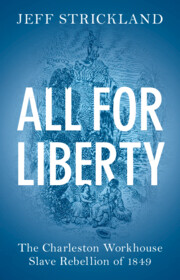Book contents
- All for Liberty
- All for Liberty
- Copyright page
- Dedication
- Epigraph
- Contents
- Figures
- Tables
- Acknowledgments
- Maps
- Introduction
- 1 Slave Insurrections in the Age of Revolutions
- 2 The Slave Workhouse
- 3 Urban Slavery
- 4 The Legal Implications of Slave Resistance
- 5 Rebellion at the Workhouse
- 6 Investigating the Rebellion
- 7 The Crisis of Fear in South Carolina
- Conclusion
- Notes
- Bibliography
- Index
4 - The Legal Implications of Slave Resistance
Published online by Cambridge University Press: 09 December 2021
- All for Liberty
- All for Liberty
- Copyright page
- Dedication
- Epigraph
- Contents
- Figures
- Tables
- Acknowledgments
- Maps
- Introduction
- 1 Slave Insurrections in the Age of Revolutions
- 2 The Slave Workhouse
- 3 Urban Slavery
- 4 The Legal Implications of Slave Resistance
- 5 Rebellion at the Workhouse
- 6 Investigating the Rebellion
- 7 The Crisis of Fear in South Carolina
- Conclusion
- Notes
- Bibliography
- Index
Summary
When William attempted to hire Nicholas out, he turned to Gadsden to broker the transaction. Not long after, Nicholas refused to hand over his pay to Gadsden’s clerk, and the man called for the city guard to take Nicholas to the workhouse. Nicholas resisted the officers sent to arrest him, expressing the sentiment that he was not afraid to die and eventually striking both men over the head with a spade. A Court of Magistrates and Freeholders tried Nicholas for grievously wounding a white man, a capital offense. Not surprisingly the court found him guilty and sentenced him to hang. However, Nicholas’s attorneys successfully appealed the case and were granted a new trial. In that proceeding, Nicholas was found guilty of a lesser offense and sentenced to a three year term in the workhouse which consisted of routine whippings and solitary confinement – not to mention witnessing the daily degradations at the house of punishment.
Keywords
- Type
- Chapter
- Information
- All for LibertyThe Charleston Workhouse Slave Rebellion of 1849, pp. 94 - 115Publisher: Cambridge University PressPrint publication year: 2021

